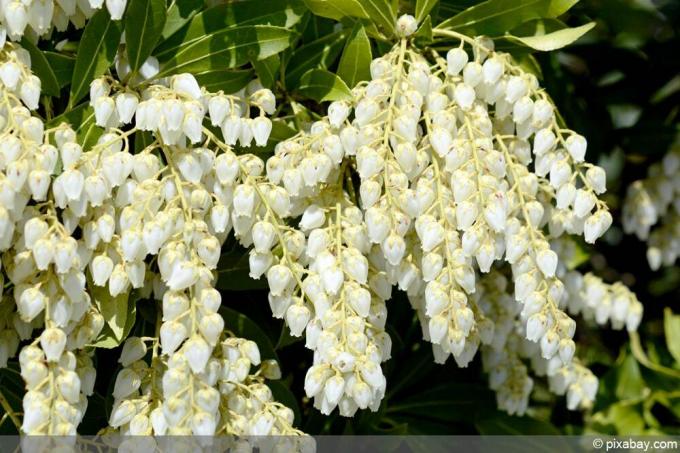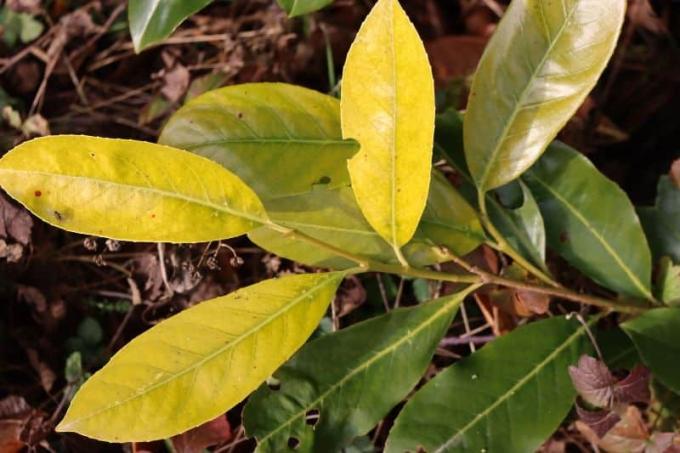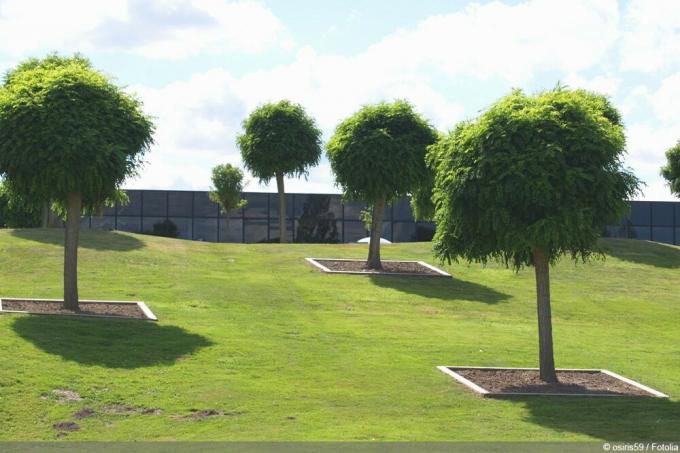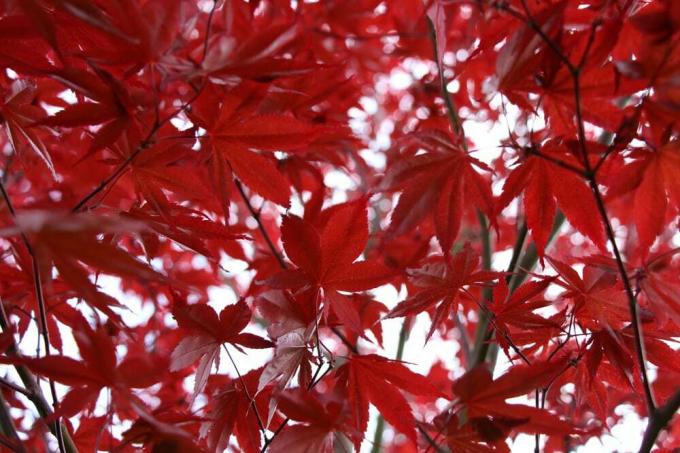

Table of contents
- fat man
- Firethorn 'Red Column'
- Evergreen Snowball
- upholstery barberry
- Portuguese laurel cherry
- Red medlar 'Red Robin'
- Columns Bergilex
- Shadowbell 'Little Heath'
- Narrow-leaved cherry laurel
- Holly 'Hedge Fairy'
- Shrub Ivy 'Arborescens'
- White-colored creeping medlar
This guide introduces x worthwhile evergreen trees and shrubs. Since they are native, they are well adapted to the local climatic conditions. Many are also suitable as privacy hedges.
fat man
- botanical name: Pachysandra terminalis
- maximum height: 20 cm to 30 cm
- Flowering time: April to May
- Flower color: white
- Fruit ornaments: no
- Location: partial shade to shade
- Soil requirements: fresh and moist, well-drained, acidic to semi-acidic

The fat man is one of the most popular ground covers in German gardens. Although it actually comes from Japan and China, it is almost considered native due to the frequent use. In this country it has many synonyms such as Japanese Ysander, Dickanthere or Schattengrün. The latter designation points to the advantage that the fat man provides color in dark corners of the garden all year round. Even the sun does not usually damage the groundcover. However, the plant loses its lush green foliage in bright locations and turns light yellow. The undemanding and easy care also contribute to the great popularity of this small-growing tree.
A notice:
In order to prevent the fat man from forming a dense, rampant carpet after a short time, pruning is urgently required.
Firethorn 'Red Column'
- botanical name: Pyracantha coccinea 'Red Column'
- maximum height: 1.5m to 2.5m
- Flowering period: May to June
- Flower color: white
- Fruit decoration: pea-sized, berry-shaped drupes in bright red
- Location: sun to semi-shade
- Soil requirements: normal garden soil, well drained

The 'Red Column' variety is considered to be the fastest growing of its kind. This makes it ideal for a garden hedge. With an average growth height of 2 m (sometimes up to 4 m), the gardener feels protected from intrusive looks, but does not feel restricted in his own garden. The bright red leaves, which are also complemented by small berry-like drupes, are a real eye-catcher that makes a firethorn hedge unique in the neighborhood. Extensive care is not required for these shrubs. A light frost protection is only recommended in late frosts and in dry summers.
A notice:
The optimal planting distance when used as a hedge is 30 to 40 cm.
Evergreen Snowball
- botanical name: Viburnum Pragenese
- maximum height: 2 to 4 m
- Flowering period: May to June:
- Flower color: white
- Fruit ornaments: no
- Location: sun to semi-shade
- Soil requirements: well-drained, nutritious, humic and fresh

The Evergreen Snowball lives up to its name. Although the creamy-white, intensely scented flowers only appear in early summer, the plant is also evergreen in winter. In addition, this specimen is very easy to care for. The upright, slightly branched growth of the dark green, glossy leaves usually does not require pruning. However, Viburnum Pragenese is happy about regular watering with old water during the cold season.
upholstery barberry
- botanical name: Berberis buxifolia
- maximum height: 60 cm to 80 cm
- Flowering period: May to June
- Flower color: orange, yellow
- Fruit ornaments: no
- Location: sun to semi-shade
- Soil requirements: all soils
The cushion barberry is wonderfully undemanding. It is suitable for greening graves and rock gardens, but also serves as a hedge. In this case, the bushes grow so close together that they become an impenetrable barrier even for cats.
Portuguese laurel cherry
- botanical name: Prunus lusitanica
- maximum height: 6 to 8 m
- Flowering time: June
- Flower color: white
- Fruit decoration: black to purple colored berries
- Location: sun to semi-shade
- Soil requirements: normal garden soil, rich in nutrients, permeable, slightly moist without waterlogging

The Portuguese laurel cherry is closely related to the cherry laurel, but due to its impressive appearance it is a very special eye-catcher in German gardens. With its white flowers, which stand in interesting contrast to the dark green, glossy foliage, it has a rather Mediterranean charm. Its growth is dense and compact and develops a handsome crown when pruned sparingly. The Portuguese laurel cherry is particularly popular as a hedge plant, as it grows into an opaque wood in a very short time. But the native shrub is also suitable for the bucket on the terrace. What is particularly noticeable here is its intense scent of honey.
Red medlar 'Red Robin'
- botanical name: Photinia fraseri 'Red Robin'
- maximum height: 1.5 m to 3 m
- Flowering period: May to June
- Flower color: white
- Fruit decoration: red globules
- Location: sun or shade
- Soil requirements: warm, lime-free, slightly loamy, humic, profound

What a sight when the brilliant white flowers of the red medlar appear against the deep red foliage in early summer. Only later in the year do the leaves take on a copper-green colour. Although this plant is native and therefore adapted to the local climate, the gardener must pay more attention to the right choice of location. Under no circumstances should the medlar be in a cold, windy place. Unfortunately, despite meeting these requirements, it is only conditionally hardy.
Columns Bergilex
- botanical name: Ilex crenata 'Fastigiata'
- maximum height: 20 cm to 25 cm
- Flowering period: May to June
- Flower color: white
- Fruit ornaments: spherical fruits
- Location: sun to semi-shade
- Soil requirements: acidic to neutral (pH 5 or 6), humic, nutritious, sufficiently moist

The leaves of these impressive trees are visually reminiscent of a boxwood. However, the pillared Bergilex has nothing in common with the spherical growth of this plant. It grows in a handsome, narrow pyramid shape. It is precisely for this reason that it is the ideal planting partner for native plants that grow spherically. Since the growth form also goes well with a bonsai, the Bergilex is mainly used in gardens that are designed according to the Japanese model. Individual branches can also be tied into wreaths.
Shadowbell 'Little Heath'
- botanical name: Pieris japonica 'Little Heath'
- maximum height: 50 cm to 60 cm
- Flowering period: late March to May
- Flower color: white
- Fruit ornaments: no
- Location: sun to semi-shade
- Soil requirements: fresh and moist, humic, well-drained, slightly acidic to acidic

This dwarf shrub is particularly impressive at the beginning of the year when its leaves sprout again. At this time, they exhibit a bright red color. Later, the coloring settles into a matt green-white. Sometimes the foliage is slightly tinged with pink.
Narrow-leaved cherry laurel
- botanical name: Prunus laurocerasus
- maximum height: up to 3 m
- Flowering time: May
- Flower color: white
- Fruit ornaments: black spherical berries (poisonous)
- Location: sunny to semi-shady
- Soil requirements: sandy, humic

Depending on the variety, the narrow-leaved cherry laurel is ideal as a hedge plant. Slender, upright growing species are particularly recommended for this purpose. And there is no shortage of species in the wood. However, all varieties have the handsome, leathery leaves in common. It is definitely worth letting Prunus laurocerasus grow, because frequent pruning inhibits flowering and fruiting.
A notice:
Prunus laurocerasus is also suitable for keeping in tubs.
Holly 'Hedge Fairy'
- botanical name: Ilex meserveae
- maximum height: 60 cm to 1.5 m
- Flowering period: May to June
- Flower color: Green-white, rather inconspicuous
- Fruit decoration: bright red berries
- Location: sun to semi-shade
- Soil requirements: rich in nutrients
Whether as a solitaire or in the hedge - the holly is an eye-catcher in every respect. The appearance of the bright red berries adds even more visual charm to the dark green foliage. In addition, the shrubs are considered to be very robust and extremely hardy. Ideal plant partners are
- ivy
- book
- mahonia
- cherry laurel
- yew
A notice:
In order for the red berries to appear again every year, the holly 'Heckenfee' needs a male pollinator. The 'Heckenstar' variety is very convenient both in name and in practice.
Shrub Ivy 'Arborescens'
- botanical name: Hedera helix 'Arborescens'
- maximum height: 1.5 m
- Flowering period: August and September
- Flower color: greenish yellow
- Fruit ornaments: no
- Location: semi-shady to shady
- Soil requirements: rich in nutrients, not too dry

This ivy species is the ideal green cover for shady, narrow gardens. Even without sunlight, it develops evergreen foliage. It also flowers relatively late in the year, making it an important source of nectar for insects before they go dormant. This shrub has little in common with the well-known climbing ivy. As a creeping plant, it is more suitable for greening dark beds.
White-colored creeping medlar
- botanical name: Euonymus
- maximum height: 30 cm to 50 cm
- Flowering period: June and July
- Flower color: inconspicuous
- Fruit ornaments: no
- Location: sun or shade
- Soil requirements: normal garden soil

In contrast to other trees and shrubs, the white-colored creeping medlar impresses less with its flowers than with its colorful foliage. The small, native shrub has pink, white and green colored foliage all year round. In early autumn, the leaves even turn slightly reddish. Small gardens in particular benefit from the very low growth height. This makes the variegated creeping medlar useless as a privacy screen, but as a groundcover its color spectacle is a worthwhile addition to any garden bed.
A notice:
The variegated creeping medlar is also satisfied with a shady location. However, the beautiful foliage color is more intense in sunny places.
 garden editorial
garden editorial I write about everything that interests me in my garden.
Learn more about shrubs

Cherry laurel has yellow / brown leaves: what to do?
Cherry laurel is one of the hardy garden plants in the garden. Nevertheless, it can happen that the leaves of the cherry laurel turn yellow or brown. The causes are manifold. Since some can kill the cherry laurel, you should investigate.

Curb Vinegar | Does bucket or root barrier help?
Vinegar trees like to spread in the garden and sometimes even drive other plants away. However, this can be avoided by curbing the growth of the trees. You can find out which methods are best suited for this here!

Rhododendron has dried up: how to save it | Rododendron
Even if the rhododendron is withered and no longer sprout, it does not have to be dead. The plant can look completely dried up above ground, but there is often still life in the roots. It is therefore worth taking appropriate measures to save the flowering shrub.

Winter jasmine, Jasminum nudiflorum | Care, propagation & pruning
The winter jasmine is a relatively frugal and robust plant that can cope with many different site conditions. The plant enchants with bright yellow flowers in winter and tolerates deep sub-zero temperatures very well. It should be pruned regularly and is easy to propagate.

Ball Tree: Care from A – Z | These 9 varieties are suitable for ball trees
Ball trees adorn many a garden, front yard and entrance area. They require little space. Their trunk thickens with age, but its height remains the same. The spherical crown is easy to trim. Nevertheless, they offer everything that makes a tree.

Red Norway Maple: Basic Care | Red-leaved maple
Red maple is well on the way to overtaking its green-leaved counterpart as a popular house tree. This guide will acquaint you with the basics of care so that the red-leaved premium variety can make the most of a representative welcoming committee in the garden.

